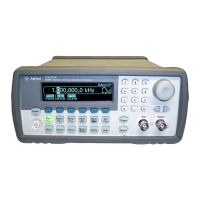227
Chapter 4 Remote Interface Reference
Burst Mode Commands
4
BURSt:INTernal:PERiod {<seconds>|MINimum|MAXimum}
BURSt:INTernal:PERiod? [MINimum|MAXimum]
Set the burst period for internally-triggered bursts. The burst period
defines time from the start of one burst to the start of the next burst.
Select from 1 µs to 500 seconds. The default is 10 ms. MAX = 500 s.
MIN = based on the burst count and waveform frequency as shown below
.
The :PER? query returns the burst period in seconds.
• The burst period setting is used only when Immediate triggering is
enabled (TRIG:SOUR IMM command). The burst period is ignored
when manual or external triggering is enabled (or when the gated
burst mode is selected).
•It is not possible to specify a burst period which is too short for the
function generator to output with the specified burst count and
frequency (see below). If the burst period is too short, the function
generator will automatically adjust it as needed to continuously
re-trigger the burst. From the remote interface, a “Data out of range”
error will be generated and the burst period will be adjusted as described.
Burst Period > + 200 ns
BURSt:PHASe {<angle>|MINimum|MAXimum}
BURSt:PHASe? [MINimum|MAXimum]
Set the starting phase for the burst in degrees or radians as specified
by the previous UNIT:ANGL command
. Select from -360 degrees to
+360 degrees or -2
π
to +2
π
radians
. The default is 0 degrees (0 radians).
MIN = -360 degrees (-2π radians). MAX = +360 degrees (+2π).
The :PHAS? query returns the starting phase in degrees or radians.
• For sine, square, and ramp waveforms, 0 degrees is the point at which
the waveform crosses zero volts (or the dc offset value) in a positive-
going direction. For arbitrary waveforms, 0 degrees is the first
waveform point downloaded to memory. This command has no effect
on pulse or noise waveforms.
• The burst phase is also used in the gated burst mode. When the gate
signal goes false, the current waveform cycle is completed and then
the function generator stops. The output will
remain at the voltage
level corresponding to the starting burst phase.
aveform Frequenc
------------------------------------------------------

